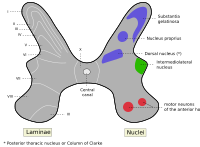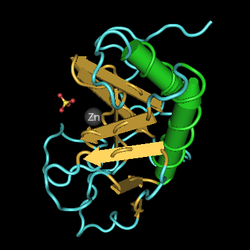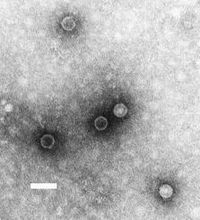Alpha motor neuron
This article includes alist of references,related reading,orexternal links,but its sources remain unclear because it lacksinline citations.(November 2013) |
| Alpha motor neuron | |
|---|---|
 Alpha motor neurons are derived from thebasal plate(basal lamina) of the developingembryo. | |
| Identifiers | |
| NeuroLexID | sao1154704263 |
| TH | H2.00.01.0.00008 |
| FMA | 83664 |
| Anatomical terms of neuroanatomy | |
Alpha(α)motor neurons(also calledAlpha motoneurons), are large,multipolarlower motor neuronsof thebrainstemandspinal cord.They innervateextrafusal muscle fibersofskeletal muscleand are directly responsible for initiating theircontraction.Alpha motor neurons are distinct fromgamma motor neurons,which innervateintrafusal muscle fibersofmuscle spindles.
While theircell bodiesare found in thecentral nervous system(CNS), α motor neurons are also considered part of thesomatic nervous system—a branch of theperipheral nervous system(PNS)—because theiraxonsextend into the periphery to innervateskeletal muscles.
An Alpha motor neuron and the muscle fibers it innervates comprise amotor unit.Amotor neuron poolcontains the cell bodies of all the Alpha motor neurons involved in contracting a single muscle.
Location
[edit]Alpha motor neurons (α-MNs) innervating theheadandneckare found in thebrainstem;the remaining α-MNs innervate the rest of the body and are found in thespinal cord.There are more α-MNs in the spinal cord than in the brainstem, as the number of α-MNs is directly proportional to the amount of fine motor control in that muscle. For example, the muscles of a single finger have more α-MNs per fibre, and more α-MNs in total, than the muscles of thequadriceps,which allows for finer control of the force a finger applies.
In general, α-MNs on one side of the brainstem or spinal cord innervate muscles on that same side of the body. An exception is thetrochlear nucleusin the brainstem, which innervates thesuperior oblique muscleof the eye on the opposite side of the face.
Brainstem
[edit]In the brainstem, α-MNs and otherneuronsreside within clusters of cells callednuclei,some of which contain the cell bodies of neurons belonging to thecranial nerves.Not allcranial nerve nucleicontain α-MNs; those that do aremotor nuclei,while others aresensory nuclei.Motor nuclei are found throughout the brainstem—medulla,pons,andmidbrain—and for developmental reasons are found near the midline of the brainstem.
Generally, motor nuclei found higher in the brainstem (i.e., more rostral) innervate muscles that are higher on the face. For example, theoculomotor nucleuscontains α-MNs that innervate muscles of the eye, and is found in the midbrain, the most rostral brainstem component. By contrast, thehypoglossal nucleus,which contains α-MNs that innervate the tongue, is found in the medulla, the most caudal (i.e., towards the bottom) of the brainstem structures.
Spinal cord
[edit]
In the spinal cord, α-MNs are located within thegray matterthat forms theventral horn.These α-MNs provide the motor component of thespinal nervesthat innervate muscles of the body.

As in the brainstem, higher segments of the spinal cord contain α-MNs that innervate muscles higher on the body. For example, thebiceps brachii muscle,a muscle of the arm, is innervated by α-MNs in spinal cord segments C5, C6, and C7, which are found rostrally in the spinal cord. On the other hand, thegastrocnemius muscle,one of the muscles of the leg, is innervated by α-MNs within segments S1 and S2, which are found caudally in the spinal cord.
Alpha motor neurons are located in a specific region of the spinal cord's gray matter. This region is designated lamina IX in theRexed lamina system,which classifies regions of gray matter based on theircytoarchitecture.Lamina IX is located predominantly in the medial aspect of the ventral horn, although there is some contribution to lamina IX from a collection of motor neurons located more laterally. Like other regions of the spinal cord, cells in this lamina aresomatotopicallyorganized, meaning that the position of neurons within the spinal cord is associated with what muscles they innervate. In particular, α-MNs in the medial zone of lamina IX tend to innervate proximal muscles of the body, while those in the lateral zone tend to innervate more distal muscles. There is similar somatotopy associated with α-MNs that innervate flexor and extensor muscles: α-MNs that innervateflexorstend to be located in the dorsal portion of lamina IX; those that innervateextensorstend to be located more ventrally.
Development
[edit]
Alpha motor neurons originate in thebasal plate,the ventral portion of theneural tubein the developingembryo.Sonic hedgehog(Shh) is secreted by the nearbynotochordand other ventral structures (e.g., thefloor plate), establishing a gradient of highly concentrated Shh in the basal plate and less concentrated Shh in thealar plate.Under the influence of Shh and other factors, some neurons of the basal platedifferentiateinto α-MNs.
Like other neurons, α-MNs sendaxonalprojections to reach their targetextrafusal muscle fibersviaaxon guidance,a process regulated in part byneurotrophic factorsreleased by target muscle fibers. Neurotrophic factors also ensure that each muscle fiber is innervated by the appropriate number of α-MNs. As with most types of neurons in thenervous system,α-MNs are more numerous in early development than in adulthood. Muscle fibers secrete a limited amount of neurotrophic factors capable of sustaining only a fraction of the α-MNs that initially project to the muscle fiber. Those α-MNs that do not receive sufficient neurotrophic factors will undergoapoptosis,a form ofprogrammed cell death.
Because they innervate many muscles, some clusters of α-MNs receive high concentrations of neurotrophic factors and survive this stage of neuronal pruning. This is true of the α-MNs innervating the upper and lower limbs: these α-MNs form large cell columns that contribute to thecervicalandlumbar enlargementsof the spinal cord. In addition to receiving neurotrophic factors from muscles, α-MNs also secrete a number oftrophic factorsto support the muscle fibers they innervate. Reduced levels of trophic factors contributes to the muscle atrophy that follows an α-MN lesion.
Connectivity
[edit]Like other neurons, lower motor neurons have both afferent (incoming) and efferent (outgoing) connections. Alpha motor neurons receive input from a number of sources, includingupper motor neurons,sensory neurons,andinterneurons.The primary output of α-MNs is toextrafusal muscle fibers.This afferent and efferent connectivity is required to achieve coordinated muscle activity.
Afferent input
[edit]| UMN origin | α-MN target | Tract name |
|---|---|---|
| Cerebral cortex | Brainstem | Corticonuclear tract |
| Cerebral cortex | Spinal cord | Corticospinal tract |
| Red nucleus | Spinal cord | Rubrospinal tract |
| Vestibular nuclei | Spinal cord | Vestibulospinal tract |
| Midbrain tectum | Spinal cord | Tectospinal tract |
| Reticular formation | Spinal cord | Reticulospinal tract |
Upper motor neurons(UMNs) send input to α-MNs via several pathways, including (but not limited to) thecorticonuclear,corticospinal,andrubrospinal tracts.The corticonuclear and corticospinal tracts are commonly encountered in studies of upper and lower motor neuron connectivity in the control of voluntary movements.
Thecorticonuclear tractis so named because it connects thecerebral cortextocranial nerve nuclei.(The corticonuclear tract is also called thecorticobulbar tract,as the target in the brainstem—which ismedulla—is archaically called the "bulb." ) It is via this pathway that upper motor neurons descend from the cortex andsynapseon α-MNs of the brainstem. Similarly, UMNs of the cerebral cortex are in direct control of α-MNs of thespinal cordvia thelateralandventral corticospinal tracts.
The sensory input to α-MNs is extensive and has its origin inGolgi tendon organs,muscle spindles,mechanoreceptors,thermoreceptors,and othersensory neuronsin the periphery. These connections provide the structure for the neural circuits that underliereflexes.There are several types of reflex circuits, the simplest of which consists of a single synapse between a sensory neuron and a α-MNs. Theknee-jerk reflexis an example of such a monosynaptic reflex.
The most extensive input to α-MNs is from localinterneurons,which are the most numerous type of neuron in thespinal cord.Among their many roles, interneurons synapse on α-MNs to create more complex reflex circuitry. One type of interneuron is theRenshaw cell.
Efferent output
[edit]Alpha motor neurons send fibers that mainly synapse onextrafusal muscle fibers.Other fibers from α-MNs synapse onRenshaw cells,i.e. inhibitoryinterneuronsthat synapse on the α-MN and limit its activity in order to prevent muscle damage.
Signaling
[edit]Like other neurons, α-MNs transmit signals asaction potentials,rapid changes in electrical activity that propagate from thecell bodyto the end of theaxon.To increase the speed at which action potentials travel, α-MN axons have large diameters and are heavilymyelinatedby botholigodendrocytesandSchwann cells.Oligodendrocytes myelinate the part of the α-MN axon that lies in thecentral nervous system(CNS), while Schwann cells myelinate the part that lies in theperipheral nervous system(PNS). The transition between the CNS and PNS occurs at the level of thepia mater,the innermost and most delicate layer ofmeningeal tissuesurrounding components of the CNS.
The axon of an α-MN connects with its extrafusal muscle fiber via aneuromuscular junction,a specialized type ofchemical synapsethat differs both in structure and function from the chemical synapses that connect neurons to each other. Both types of synapses rely onneurotransmitterstotransducethe electrical signal into a chemical signal and back. One way they differ is that synapses between neurons typically useglutamateorGABAas their neurotransmitters, while the neuromuscular junction usesacetylcholineexclusively. Acetylcholine is sensed bynicotinic acetylcholine receptorson extrafusal muscle fibers, causing their contraction.
Like other motor neurons, α-MNs are named after the properties of theiraxons.Alpha motor neurons haveAα axons,which are large-caliber,heavilymyelinatedfibers that conductaction potentialsrapidly. By contrast,gamma motor neuronshaveAγ axons,which are slender, lightly myelinated fibers that conduct less rapidly.
Clinical significance
[edit]
Injury to α-MNs is the most common type of lower motor neuronlesion.Damage may be caused bytrauma,ischemia,andinfection,among others. In addition, certain diseases are associated with the selective loss of α-MNs. For example,poliomyelitisis caused by avirusthat specifically targets and kills motor neurons in the ventral horn of the spinal cord.Amyotropic lateral sclerosislikewise is associated with the selective loss of motor neurons.
Paralysisis one of the most pronounced effects of damage to α-MNs. Because α-MNs provide the only innervation toextrafusal muscle fibers,losing α-MNs effectively severs the connection between the brainstem and spinal cord and the muscles they innervate. Without this connection, voluntary and involuntary (reflex) muscle control is impossible. Voluntary muscle control is lost because α-MNs relay voluntary signals from upper motor neurons to muscle fibers. Loss of involuntary control results from interruption ofreflex circuitssuch as the tonicstretch reflex.A consequence of reflex interruption is thatmuscle toneis reduced, resulting inflaccid paresis.Another consequence is the depression ofdeep tendon reflexes,causinghyporeflexia.
Muscle weakness andatrophyare inevitable consequences of α-MN lesions as well. Because muscle size and strength are related to the extent of their use, denervated muscles are prone to atrophy. A secondary cause of muscle atrophy is that denervated muscles are no longer supplied with trophic factors from the α-MNs that innervate them. Alpha motor neuron lesions also result in abnormalEMGpotentials (e.g.,fibrillation potentials) andfasciculations,the latter being spontaneous, involuntary muscle contractions.
Diseases that impair signaling between α-MNs and extrafusal muscle fibers, namelydiseases of the neuromuscular junctionhave similar signs to those that occur with α-MN disease. For example,myasthenia gravisis anautoimmune diseasethat prevents signaling across theneuromuscular junction,which results in functional denervation of muscle.
See also
[edit]References
[edit]- John A. Kiernan (2005).Barr's the Human Nervous System: An Anatomical Viewpoint(8th ed.). Hagerstown, MD: Lippincott Williams & Wilkins.ISBN0-7817-5154-3.
- Duane E. Haines (2004).Neuroanatomy: An Atlas of Structures, Sections, and Systems(6th ed.). Hagerstown, MD: Lippincott Williams & Wilkins.ISBN0-7817-4677-9.
External links
[edit]- NIF Search - Alpha Motor NeuronArchived2016-03-04 at theWayback Machinevia theNeuroscience Information Framework
